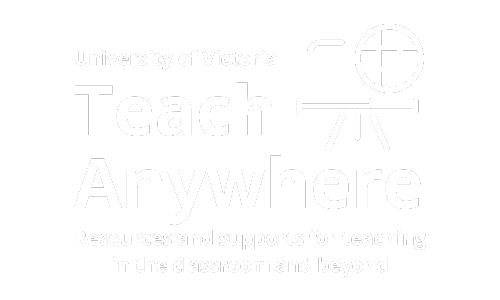Teach a Course
Find resources to guide you as you revise, design, or redesign your course in the sequential order of design from context to syllabus
Jump to Section
Course Context
How do I begin to think about my course?At UVic, we take a learning-centred approach to teaching. That means the focus is on student learning. Ways in which we are student centred is through holding high expectations of students and providing high support for students. As you begin to revise or redesign your course, you want to first consider the context of the learning environment. This also includes providing learning that is universal.
More on course contextUniversal Design for Learning (UDL)
Learning Outcomes
What is an intended learning outcome (ILO)?An intended learning outcome (ILO) describes the learning intention by clarifying what the learner will think, value, do, or more by the end of the course/lesson. The following information will guide you as you develop or revise your ILOs for your course and lessons.
How to use ILOs
Accessibility
How can I increase accessibility in my course?Accessibility in your course is important, it supports educational equity and increases opportunities for students to succeed. The following resources will provide guidance and knowledge on incorporating accessibility in your course. The resources include a Universal Design for Learning Guide as well as Brightspace accessibility features and tips for creating accessible course content design.
Accessibility in my classes
Assessment
How will I evaluate my students?Assessment is any mechanism instituted in a course to provide feedback and measure student learning. Many factors contribute to how assessment is approached.
More on assessmentLearn about ePortfolios to assess students
Instructional Strategies
How can I teach my course effectively?Instructional strategies includes facilitating and engaging students while teaching by being present as an instructor, communicating with your students, and providing interactive lesson plans and activities. There are many different instructional strategies that you can use but most important is that what you use aligns with your intended learning outcomes and assessment strategies. In the links below, you will find examples of possible instructional strategies that promote active learning.
Learning-centred instructional strategiesStrategies for teaching online
Technology & Tools
How do I teach using educational techologies?You have built a new educational technology into your course and now you’re ready to start teaching. Teaching in a blended format or online, or with a new technology in your face-to-face course changes the options available to you and may change the teaching strategies you use. We are also learning more and more about how artificial intelligence impacts our learning and teaching.
Learn about UVic's educational technologiesRead our GenAI resources
Developing a Syllabus
What do I need to outline my course?No single syllabus format or content applies to every university course. However, a number of components can make the course syllabus more informative, useful, and engaging. Your course syllabus engages and informs students and focuses your teaching. It reflects the overall organization and purpose of the course. It is a structured snapshot of the course that you can preserve in your teaching dossier. It also facilitates the evaluation of your teaching.
Components of a well-designed syllabus
